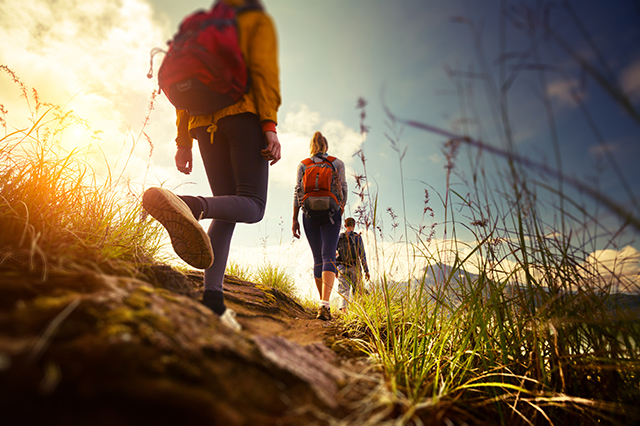The Northeast is home to a plethora of great hiking spots for every skill level. But if you’ve never hiked before, hitting the trails might feel a bit intimidating. See how to prepare, dress and pack for your first hike with this list of tips and other hiking essentials for beginners.
Before Your Hike
Prior to your outing, take a couple of steps in advance to make the most of your hike later.
First, check the weather forecast. Not only will you want to know the temperature to decide how to dress, avoiding precipitation is key to a safer, less stressful hike.
Eat a hearty, healthy breakfast or lunch, depending on when you plan to hike. You’ll want plenty of energy to get you through your trek.
Let someone (a family member, friend, neighbor, etc.) know where you’re going, especially if you’re heading out alone – just in case you get lost or injured during your hike.
If you plan to do a lot of hiking this season, consider taking a first aid or navigation course. The American Red Cross, Adirondack Mountain Club and Appalachian Mountain Club are both helpful sources.
Hiking Essentials for Beginners
The perfect list of hiking essentials varies from person to person, but these supplies are a good place to start.
Suitable Shoes
Proper footwear is arguably the most important item for a hike. To find your best hiking shoes, consider your athletic ability, experience level and the type of hiking you’ll be doing.
If you have strong ankles, lightweight boots or trail-running shoes are sufficient, otherwise go for stiffer midweight hiking boots.
Once you have a type of shoe in mind, you’ll want to make sure the fit is right.
“Your heel should be locked in place inside the boot to prevent blister-causing friction, and there should be minimal extra space around your foot (although you should be able to wiggle your toes freely),” according to the Appalachian Mountain Club.
Pro tip: It’s best to break in new shoes before going on a longer hike.
Water Bottle
Staying hydrated is imperative during a hike. Have at least one quart of water for each person on your trip.
Reusable bottles are the way to go. Wide-mouth, collapsible and insulated bottles are all great options.
Also, consider a way to purify more water in case of an emergency. Squeeze-style or pump filters take up some room and require a bit of effort to use but are better for groups or longer trips. Bottles like the GRAYL GeoPress and Katadyn BeFree come with filters, making them a good backup for solo treks.
See this guide for information on boiling water, chemical treatments and using ultraviolet light to kill microorganisms and purify water.
Bug Repellant
Using insect repellant can help keep you protected against mosquito-borne illnesses as well as Lyme disease and other diseases carried by ticks.
Bug repellants come in many forms, including sprays, lotions, oils and wipes. Each has their own pros and cons, so choose which best suits your needs. Four of the most common ingredients in bug repellants are DEET, picaridin, permethrin and oil of lemon eucalyptus.
DEET and picaridin are effective against biting insects by hiding your scent. Both can be used on the skin and clothing. DEET offers a few more hours of protection by comparison but will damage plastics and certain clothes, can come off as you sweat and feels greasy to some people. Picaridin is odorless and non-greasy.
Permethrin should not be applied to your skin. Being an insecticide, permethrin kills mosquitoes and other bugs that come in contact with it. “Use 0.5% permethrin to treat clothing and gear (such as boots, pants, socks and tents) or buy permethrin-treated clothing and gear,” according to the Centers for Disease Control and Prevention.
Oil of lemon eucalyptus is moderately effective compared to the others but is more natural. It’s the most effective and long-lasting plant-derived formula; however, some products shouldn’t be used on children under three, according to the EPA.
Always use bug-repellant products as directed, and try wearing long sleeves and pants for another layer of protection. Use the EPA search tool to find your preferred bug repellant.
Pro tip: Bring a lint roller and use it to help pull ticks off your clothing after a hike.

Fit Aid Kit
You can buy a pre-assembled first aid kit or create your own.
Either way, make sure you have these essentials: antibiotic ointment, hydrocortisone cream, bandages, gauze, adhesive tape and adhesive padding (like moleskin) to treat cuts/scrapes, bug bites/stings and blisters. You’ll also want supplies to treat a sprain, like ACE bandages and a pain reliver/inflammation reducer, like ibuprofen.
To complete your first aid kit, consider a pair of scissors – to cut gauze, moleskin, etc. – and a whistle to alert others if you’re ever in trouble.
Rations
Bring along some calorie-dense foods to keep you feeling full and energized during your hike.
Snacks like jerky and energy/protein bars (like Larabar, Clif Bar, ProBar, Luna and Kind) are quick and easy, but be wary of too much salt, which can make you feel thirsty.
Nuts and seeds – like almonds, peanuts, walnuts and sunflower seeds – and nut butters are lightweight and packed with protein. Dried fruits and berries, like banana chips, dried cherries and raisins, along with dark chocolate, have a good amount of calories and will satisfy a sweet tooth. Put it all together to make a trail mix.
Spare Clothes
When dressing for a hike, layering is a great way to stay warm or cool off.
Wear or bring a hat, like a baseball cap to block the sun or a beanie to keep your head and ears warm. Also, have an extra pair of socks, in case your feet get too damp with sweat or you sustain an injury.
“Good hiking socks wick moisture away from your skin and provide padding for your feet,” according to Appalachian Mountain Club. You should avoid cotton, and go for a mix of materials, like acrylic, nylon, polyester and polypropylene (or olefin). These synthetic fibers dry quickly and add durability.
Finally, consider a light jacket to combat a chilly breeze or sudden shower. A water resistant nylon windbreaker is lightweight and will keep your dry for a short period of time. A waterproof jacket will keep you drier, but will likely be heavier as well.
Sun Protection
You’ll also want to protect your skin and eyes from the sun’s harmful rays.
Go for sunglasses that feel comfortable sitting on your face and ears while offering ultraviolet protection. When it comes to sunscreen or suntan lotion, the FDA recommends using a broad-spectrum SPF 15 sunscreen for protection, but the American Academy of Dermatology recommends using a broad-spectrum sunscreen with an SPF of 30 or higher.
Sun protection clothing and lip balm are other supplies worth considering.
Navigation
Navigation tools like a map and compass are trustworthy and essential – you don’t have to worry about batteries dying or losing a signal. Always carry a map of the trail; if you take a picture of it on your smartphone, you’ll be able refer to the map on your camera roll even if there’s no cell service.
For an added level of security, consider a separate GPS device or personal locator beacon.
Light and Heat
In case clouds roll in or sunset comes faster than you were excepting, consider bringing a light source. A simple flashlight – separate from the one on your phone – or a headlamp, to keep your hands free, will do.
A lighter, waterproof matches and/or fire starter are other helpful tools. They’ll offer light and the ability to make a fire, if needed.
Miscellaneous
Some additional tools you might want to consider for your hike are a knife, multipurpose tool and/or duct tape. A multipurpose tool will help you repair to your sunglasses, cut a piece of gauze, pull out a splinter and more.
You might also want to bring some emergency shelter. A tarp, Bivy bag or emergency blanket are all good options – and a heavy-duty garbage bag will do in a pinch.
Sanitation
Bring along some travel-size hand sanitizer and/or disinfectant wipes and a spare face mask.
Backpack
Last, but certainly not least, you’ll need a way to carry all your hiking supplies. A backpack is the perfect method.
You’ll want a pack with comfortable straps, plenty of pockets and a loop/key ring or two for a carabiner and/or your safety whistle, hand sanitizer, etc.
Comfortable, lightweight backpacks like the Osprey Daylite Daypack and Gregory Packs are great for hiking beginners.
Pro tip: Bring a trash bag to keep garbage away from the rest of your supplies.
If you’re planning on a longer trip outdoors, AAA members can save on RV rentals at Outdoorsy.
Are you going hiking this season? Tell us about it in the comments.
10 Thoughts on “Hiking Essentials for Beginners”
Leave A Comment
Comments are subject to moderation and may or may not be published at the editor’s discretion. Only comments that are relevant to the article and add value to the Your AAA community will be considered. Comments may be edited for clarity and length.















I recommend using a pair of hiking poles (lightweight and height adjusted). They help with posture, breathing, balance and security over every type of terrain from flat to rough.
An old cd works as good as a mirror and won’t break
A non-breakable mirror for signaling searchers is something that rarely fails in desperate situations.
I always like to bring a hiking stick or pole, especially if a change in elevation is part of the hike.
Thank you for all the helpful tips. Your articles are so informative and have been more than helpful on many occasion. I appreciate all who work so hard to keep us safe and informed every day. My love and appreciation to all!
Hi, Brenda. Thank YOU for reading and commenting!
I also bring a small roll of toilet paper in a plastic bag with a bottle of hand sanitizer in the middle. Compact and easy to lend to another.
An essential piece of gear was left out of the list – rain gear. It is recommended that a poncho or water repellent coat be ALWAYS taken on every hike.
Hi, Robbie. You’re right; rain gear is essential. We suggest bringing at least a light jacket that’s wind/water resistant under the “Spare Clothes” section.
Thanks for reading and commenting!
where’s the GPS locator recommended by the canam project? Absolutely essential with all the things that can happen on a trek.